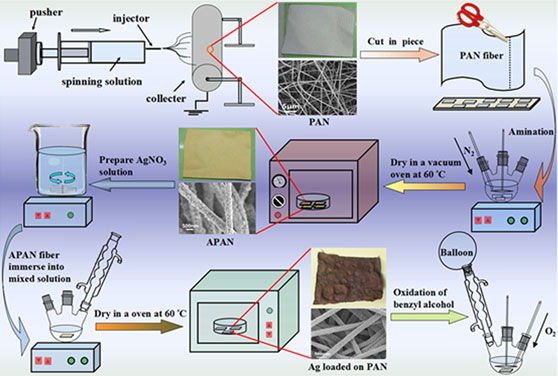Crossref Citations
This article has been cited by the following publications. This list is generated based on data provided by
Crossref.
Yu, Bo
Liu, Yongkun
Jiang, Guohua
Liu, Depeng
Yu, Weijiang
Chen, Hua
Li, Lei
and
Huang, Qin
2017.
Preparation of electrospun Ag/g-C3N4 loaded composite carbon nanofibers for catalytic applications.
Materials Research Express,
Vol. 4,
Issue. 1,
p.
015603.
Samanta, Archana
Takkar, Sonam
Kulshreshtha, Ritu
Nandan, Bhanu
and
Srivastava, Rajiv K
2017.
Nano-silver stabilized Pickering emulsions and their antimicrobial electrospun fibrous matrices.
Biomedical Physics & Engineering Express,
Vol. 3,
Issue. 3,
p.
035011.
Liu, Yongkun
Huang, Qin
Jiang, Guohua
Liu, Depeng
and
Yu, Weijiang
2017.
Cu2O nanoparticles supported on carbon nanofibers as a cost-effective and efficient catalyst for RhB and phenol degradation.
Journal of Materials Research,
Vol. 32,
Issue. 18,
p.
3605.
Liu, Yongkun
Jiang, Guohua
Li, Lei
Chen, Hua
Huang, Qin
Du, Xiangxiang
and
Tong, Zaizai
2017.
Electrospun CeO 2 /Ag@carbon nanofiber hybrids for selective oxidation of alcohols.
Powder Technology,
Vol. 305,
Issue. ,
p.
597.
Liu, Yongkun
Jiang, Guohua
Sun, Shiqing
Xu, Bin
Zhou, Junyi
Zhang, Yang
and
Yao, Juming
2017.
Growth of NiCo2S4 nanotubes on carbon nanofibers for high performance flexible supercapacitors.
Journal of Electroanalytical Chemistry,
Vol. 804,
Issue. ,
p.
212.
Liu, Yongkun
Jiang, Guohua
Sun, Shiqing
Xu, Bin
Zhou, Junyi
Zhang, Yang
and
Yao, Juming
2018.
Decoration of carbon nanofibers with NiCo2S4 nanoparticles for flexible asymmetric supercapacitors.
Journal of Alloys and Compounds,
Vol. 731,
Issue. ,
p.
560.
Boonying, Patharawadee
Narkkun, Thanitporn
Naowanon, Wittawinwit
Amnuaypanich, Sujitra
Hung, Wei-Song
and
Amnuaypanich, Sittipong
2019.
Rapid decolorization of methyl orange using polyacrylonitrile membranes incorporated with nickel nanoparticles loaded in block copolymer micelles.
Separation and Purification Technology,
Vol. 223,
Issue. ,
p.
203.
Allen, Joseph Anthuvan
Murugesan, Duraisamy
and
Viswanathan, Chinnuswamy
2019.
Circumferential growth of zinc oxide nanostructure anchored over carbon fabric and its photocatalytic performance towards p-nitrophenol.
Superlattices and Microstructures,
Vol. 125,
Issue. ,
p.
159.
Miao, Lei
Liu, Guojun
and
Wang, Jiandong
2019.
Ag-Nanoparticle-Bearing Poly(vinylidene fluoride) Nanofiber Mats as Janus Filters for Catalysis and Separation.
ACS Applied Materials & Interfaces,
Vol. 11,
Issue. 7,
p.
7397.
Rehan, Mohamed
Nada, Amr A.
Khattab, Tawfik A.
Abdelwahed, Nayera A.M.
and
El-Kheir, Amira Adel Abou
2020.
Development of multifunctional polyacrylonitrile/silver nanocomposite films: Antimicrobial activity, catalytic activity, electrical conductivity, UV protection and SERS-active sensor.
Journal of Materials Research and Technology,
Vol. 9,
Issue. 4,
p.
9380.
Wang, Meng
Yuan, Bin
and
Bai, Shibing
2020.
Preparation of Ag/C fiber with nanostructure through in situ thermally induced redox reaction between PVA and AgNO3 and its catalysis for 4‐nitrophenol reduction.
Polymers for Advanced Technologies,
Vol. 31,
Issue. 6,
p.
1312.
Yuan, Bin
Yang, Shuangqiao
Wang, Meng
Jiang, Xia
and
Bai, Shibing
2020.
Preparation of Ag foam catalyst based on in-situ thermally induced redox reaction between polyvinyl alcohol and silver nitrate with supercritical CO2 foaming technology.
Polymer,
Vol. 206,
Issue. ,
p.
122858.
Chernykh, Mariia
Mikheeva, Natalia
Zaikovskii, Vladimir
Salaev, Mikhail
Liotta, Leonarda F.
and
Mamontov, Grigory
2020.
Room-Temperature Nitrophenol Reduction over Ag–CeO2 Catalysts: The Role of Catalyst Preparation Method.
Catalysts,
Vol. 10,
Issue. 5,
p.
580.
Cheng, Po-Wei
Chen, Chun-Yi
Ichibayashi, Taku
Chang, Tso-Fu Mark
Sone, Masato
and
Nishimura, Suzushi
2021.
Metallization of 3D-printed polymer structures via supercritical carbon dioxide-assisted electroless plating.
MRS Communications,
Vol. 11,
Issue. 3,
p.
278.
Nekounam, Houra
Kandi, Mohammad Reza
Shaterabadi, Donya
Samadian, Hadi
Mahmoodi, Narges
Hasanzadeh, Elham
and
Faridi-Majidi, Reza
2021.
Silica nanoparticles-incorporated carbon nanofibers as bioactive biomaterial for bone tissue engineering.
Diamond and Related Materials,
Vol. 115,
Issue. ,
p.
108320.
Tikhonov, N. I.
Khutsishvili, S. S.
Vakul’skaya, T. I.
Kuznetsova, N. P.
Emel’yanov, A. I.
and
Pozdnyakov, A. S.
2021.
Formation of Silver-Containing Nanocomposites during Thermolysis of Polyacrylonitrile Salt: EPR Study.
Polymer Science, Series B,
Vol. 63,
Issue. 2,
p.
175.
Gu, Jiatai
Zheng, Maorong
Zhu, Tianxue
Wang, Ni
Wang, Liming
Yu, Jianyong
and
Qin, Xiaohong
2022.
Electrostatic-Modulated Interfacial Crosslinking and Waterborne Emulsion Coating Toward Waterproof, Breathable, and Antifouling Fibrous Membranes.
SSRN Electronic Journal,
Yang, Zixuan
Zhu, Junjiang
Xiao, Ping
and
Wang, Xungai
2023.
Polyacrylonitrile/cellulose nanofiber supported gold nanoparticles for liquid-phase aerobic oxidation of benzyl alcohol to benzaldehyde.
Cellulose,
Vol. 30,
Issue. 14,
p.
8941.
Gu, Jiatai
Zheng, Maorong
Zhu, Tianxue
Wang, Ni
Wang, Liming
Yu, Jianyong
and
Qin, Xiaohong
2023.
Electrostatic-modulated interfacial crosslinking and waterborne emulsion coating toward waterproof, breathable, and antifouling fibrous membranes.
Chemical Engineering Journal,
Vol. 454,
Issue. ,
p.
140439.
Chavez-Esquivel, G
Cervantes-Cuevas, H
Cortes-Cordova, D E
Estrada de los Santos, P
and
Huerta Arcos, L
2024.
Silver-doped graphite oxide composites used as antimicrobial agents against Staphylococcus aureus, Escherichia coli and Tatumella terrea evaluated by direct TLC bioautography.
Nano Express,
Vol. 5,
Issue. 1,
p.
015013.





